On 13th August 2020, Vimarsh was held through a webinar at VIF, on the topic “Ayodhya Movement and National Polity.” This subject was thoroughly reviewed by Shri S Gurumurthy, Economic & Political Analyst and Chairman, VIF. The Ayodhya movement has been inextricably linked with the national polity for almost five decades now. The Bhoomi Pujan ceremony that was held in Ayodhya on the 5th of August, 2020 marks the beginning of a new narrative for National Polity.
The session began with an invocation, following which Dr Arvind Gupta, Director VIF addressed the gathering. In his opening statement, Dr Arvind Gupta remarked how the Ayodhya movement, which has been a long-festering wound in our polity, will finally, be a thing of the past with the construction of the temple underway. After a brief introduction, Dr Arvind Gupta called upon Shri Gurumurthy, the speaker of the hour to take over and begin the session formally.
Shri Gurumurthy then began the session by delving into the intricate history of the Ayodhya movement and its misinterpretations by those who are of left/liberal persuasion. He remarked how the movement, which initially started for a temple, ended up reinstating the values of the freedom movement. He described the Ayodhya movement as a “paradigm shift” both on the ground and at the top. This paradigm shift has led to massive breakthroughs and played a pivotal role in uniting India. S Gurumurthy brought out three important points associated with the movement which are: -
- The Ayodhya movement brought durability to national polity which had been lost in vote bank politics.
- It redefined the minority-centric secular India into an inclusive India, which respected the majority as well.
- It restored the civilisational nationalistic character of India.
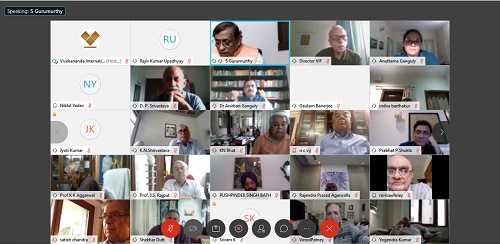
The aforementioned points were dissected systematically by Shri Gurumurthy who then went on to discuss the historical background of this movement. According to the numerous surveys undertaken by the Archaeological Survey of India, the findings unearthed present solid evidence that a temple did exist underneath the disputed structure. These findings were widely and peacefully accepted by the public until the left-wing intervened. According to Shri Gurumurthy, the so-called secular and liberal political flanks of India were heavily involved in the movement at that point of time which began to change the nature of the movement, making it violent and heavily politicised.
The intervention of the left in the past changed the course of the movement entirely. A movement which began to simply restore a temple became the most sought-after communal issue, pitting India’s majority against its minorities. Gurumurthy ji emphasised the fact that the issue at hand was never Hindu vs Muslims and was blown out of proportion by the left.
He describes our fixation with the past as one of our main roadblocks on the path to secularism. Some profound examples include Aurangzeb’s strategic planning and construction of Mosques in predominantly Hindu neighbourhoods. These mosques were seen as provocative symbols by many and aimed to relay the message that an imperial ruler was in power. Several historians and archaeologists have conveyed the fact that our reluctance to let go of our past, whether this is colonial architecture or symbols of our invaders, conveys that we’re still reeling from a colonial hangover.
Shri Gurumurthy then peered into the past to look for cues that defined our future. A turning point in history was the reconstruction of the Somnath temple. Shri Gurumurthy went on to quote K M Munshi, who was the food and agriculture minister and also responsible for the construction of the temple. According to KM Munshi, the cabinet Jawaharlal Nehru presided over decided to reconstruct the historic Somnath temple at government expenditure. Gandhiji, however, advised Sardar Patel to collect funds from the people for this purpose which was graciously accepted by Patel. This led to the appointment of KM Munshi as the chairman of the advisory committee for the reconstruction of the temple.
Once the temple was ready for inauguration, Dr Rajendra Prasad was invited for this momentous occasion. Nehru, however, advised him against making an appearance since he wanted there to be a clear distinction between the church and the state and Dr Rajendra Prasad’s appearance would have given the wrong impression. Nehru’s stance on the Somnath Temple post Gandhi and Patel’s death changed rapidly. He started seeing the temple as a symbol of Hindu revivalism and this point of his was countered by KM Munshi in a letter where he assured that the ‘Collective Subconscious’ of India today is happier with the scheme of reconstruction. This change in Nehru’s position was, according to Gurumurthy ji, the turning point in the history of the state and secularism in independent India.
In his concluding remarks, Shri Gurumurthy spoke about the essence of Hindutva and its gross misinterpretation across the country. Hindutva has often been seen as an ideology that propagates communalism. This, however, is far from the truth. In its basic sense, Hinduism and Hindutva aren’t separate from each other. They both come together to form the cultural and national ethos of India and are deeply rooted in values of inclusivity, peace and harmony. The path ahead is brimming with potential that will accelerate India’s growth. However, discernment to cut through the mirage of false news that sparks communal tensions is necessary too.

.jpg)
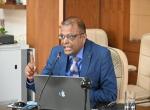
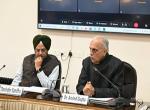
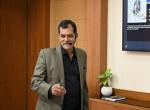
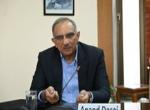
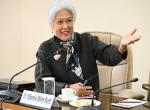


Post new comment